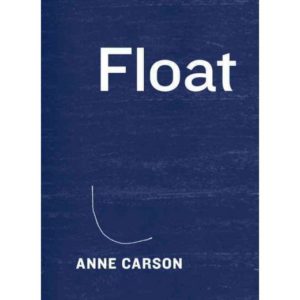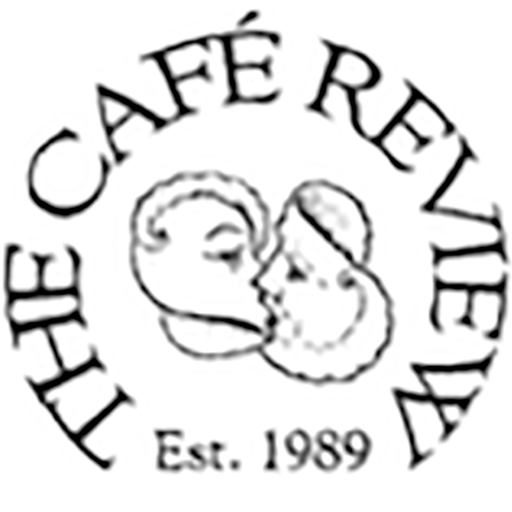Float
Float, A Collection of Tw enty-two Chapbooks Whose Order is Unfixed and Whose Topics are Various,
enty-two Chapbooks Whose Order is Unfixed and Whose Topics are Various,
by Anne Carson, Knopf, 2016,
272 pages, paper, $30.00, ISBN# 978-1-101-94684-8
Reading Anne Carson does things to my body. I’m not sure I can fully explain it, but there’s a freshness to reading her like a sharp blade between ribs — “a thin edge that appears where no edge is scheduled” — and I’m either laughing at the brilliant reflection within this entry, this art, or I’m scrambling, grappling with meaning, trying to hold on to something that’s undoing itself in front of me like a building collapsing in slow-mo. You know that kind of laugh you get when you suddenly see yourself ? Ha. The whole theater played out before you like a giant pile of glittering dust. So much opened up, so much exposed, and then a cave-mouth smoking out its frank and welcome air. Which is all to say, Carson is one of our most restlessly — relentlessly — experimental poets. She always seems to be driving with her hands off the wheel, magically keeping the whole thing in motion.
Carson is trained as a classicist and teaches ancient Greek for a living. Her previous essays and poetry are peppered with sharp feminist analysis of those foundational Greek myths that still ground and torment us. This collection contains such references, and also reveals how much she has worked with other artists in collaboration or on commission — Roni Horn, Laurie Anderson, Tacita Dean, members of the Merce Cunningham Dance Company, novelists Joan Juliet Buck and Will Aitken, to name a few. You can tell she finds rich ferment in these dialogues and intersections. She also seems to know a whole lot about art. The short piece “Eras of Yves Klein” had me rolling in the aisles with its sly presentation and savvy critique. The piece echoes with meanings. But the works are not only for those in the know — you might have to do a little research, but reading “Merry Christmas from Hegel,” for example, simply lets you in on the atmosphere she encountered while reading Hegel, one that led her to “snow standing” one lonely Christmas Day after her brother died. It’s an exquisite prose poem. You don’t have to know Hegel to get it, but it adds another layer.
The first piece in the collection that took my breath away is “Cassandra Float Can,” a “lecture in three parts . . . [that was] accompanied in performance by images of the works of Gordon Matta-Clark shown as slides and on large posters carried about the room.” Moving swiftly from Cassandra, whose prophecies were beyond belief, and the “tautological” arts of prophesy — “they reason in a circle” — to questions of translation, she notes both translation and prophesy cut through surfaces “to a site that has no business being underneath.” What does she mean here? You have to follow her mind through the text and its accumulation of provocative ideas and things — Edmund Husserl’s 30,000 pages of unpublished Bavarian shorthand, the rate of thought as compared to that of speech, the question of an original surface, veils, the Romantics, and the notion that compared to the domestication of a sentence, a text might remain “wild,” cut free from use. This brings us to the cuts of Gordon Matta-Clark and his “retranslations” of space. It’s a magisterial gaze that absorbs the finest lines of thought and, through layering, brings us to a very “thin edge of seeing.”
Another chapbook, “Stacks,” works in layers. Prophesy reappears, and so do cuts and edges. This series is comprised of lists and re-orderings — re-viewings — of material. Jezebel, the false prophet who is thrown out the window to the dogs by her own court for her transgressions, inhabits these poems. In “Shame Stack,” which contains a working out of the difference between shame and guilt (shame requires the eyes of others), we are told:
No one could
relax around Jezebel. Psychoanalysts say that
shame ruins your capacity for reverie by making cracks
in the mind where it is dangerous for thought to wander.
And into this crack pour poems: a list of seas on the moon, a “Stack of Definitions of Stack,” five “Thunderstorm Stacks” that thrash through the chapbook asking to be heard. Did you know that “Bronte” means “thunder” in ancient Greek? Various initial poems (“Stacks”) are subsequently “re-stacked,” re-tooled, fleshed out and counted. It’s fun and funny and also full of rage. Carson is exorcising demons from within the words. She pushes her language to the edge of meaning and asks us again, where lies the edge of belief ? Who decides whose prophecy is heard?
This poem seems to offer a playful methodology for reading the entire collection. Turn it over, shuffle it and re-stack it. The pile of chapbooks can get unwieldy — it slips out of its plastic case, off your lap, and disorders — but this seems to be exactly what Carson wants: for her reader to find a new order, to flesh out fresh connections between things. And, it may in fact be this fresh kind of seeing that most impresses the reader.
“Variations on the Right to Remain Silent” is an astounding essay on art and the art of translation and those places where language “falls silent” and refuses to mean, refuses to be translatable. Odysseus, Joan of Arc, Francis Bacon, Hölderlin, and Paul Celan are our guides for this essay that falls apart into a raucous series of playful mis /translations by its end. Each of these figures exhibits a genius answer to cliché — each of them exhibits a kind of “catastrophizing” of language and meaning, a refusal and resistance to the everything-already-said:
We resort to cliché because it’s easier than trying to make
up something new.
Implicit in it is the question, “Don’t we already know what
we think about this?”
Her point is, perhaps we don’t. Or we shouldn’t. To read Anne Carson is to enter a mind at work, follow the swift movement of thoughts and things in order to reconstruct meaning — or to unravel it. And it’s always unexpected, always something new.
— Julie Poitras Santos

